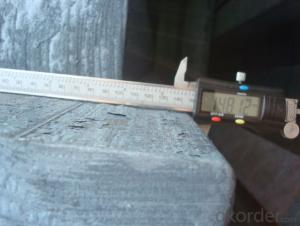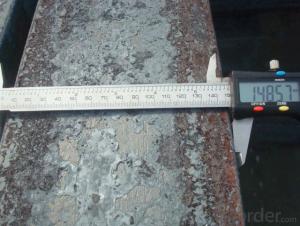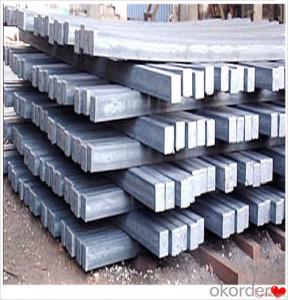Square Shape Hot Rolled Mild Steel Billet 60mm-150mm
- Loading Port:
- China main port
- Payment Terms:
- TT or LC
- Min Order Qty:
- 1000 m.t.
- Supply Capability:
- 10000 m.t./month
OKorder Service Pledge
OKorder Financial Service
You Might Also Like
Product Description:
OKorder is offering Square Shape Hot Rolled Mild Steel Billet 60mm-150mm at great prices with worldwide shipping. Our supplier is a world-class manufacturer of steel, with our products utilized the world over. OKorder annually supplies products to African, South American and Asian markets. We provide quotations within 24 hours of receiving an inquiry and guarantee competitive prices.
Product Applications:
Square Shape Hot Rolled Mild Steel Billet 60mm-150mmare ideal for structural applications and are widely used in the construction of buildings and bridges, and the manufacturing, petrochemical, and transportation industries.
Product Advantages:
OKorder's Square Shape Hot Rolled Mild Steel Billet 60mm-150mm are durable, strong, and wide variety of sizes.
Main Product Features:
· Premium quality
· Prompt delivery & seaworthy packing (30 days after receiving deposit)
· Can be recycled and reused
· Mill test certification
· Professional Service
· Competitive pricing
Product Specifications:
Manufacture: Hot rolled
Grade: Q195/Q235/Q275/20MnSi
Certificates: ISO, SGS, BV
size:60*60/90*90/100*100/120*120/150*150
Length: 6m/12m,
Packaging: Export packing, nude packing, bundled
Standard | C(%) | Mn(%) | S(%) | P(%) | Si(%) |
Q195 | ≤0.12 | ≤0.50 | ≤0.040 | ≤0.035 | ≤0.30 |
Q235 | ≤0.20 | ≤1.40 | ≤0.045 | ≤0.045 | ≤0.35 |
Q275 | ≤0.22 | ≤1.50 | ≤0.045 | ≤0.045 | ≤0.35 |
20MnSi | 0.17-0.25 | 1.2-1.6 | ≤ 0.050 | ≤ 0.050 | 0.40-0.80 |
FAQ:
Q1: Why buy Materials & Equipment from OKorder.com?
A1: All products offered byOKorder.com are carefully selected from China's most reliable manufacturing enterprises. Through its ISO certifications, OKorder.com adheres to the highest standards and a commitment to supply chain safety and customer satisfaction.
Q2: How do we guarantee the quality of our products?
A2: We have established an advanced quality management system which conducts strict quality tests at every step, from raw materials to the final product. At the same time, we provide extensive follow-up service assurances as required.
Q3: How soon can we receive the product after purchase?
A3: Within three days of placing an order, we will arrange production. The normal sizes with the normal grade can be produced within one month. The specific shipping date is dependent upon international and government factors, the delivery to international main port about 45-60days.
Images:
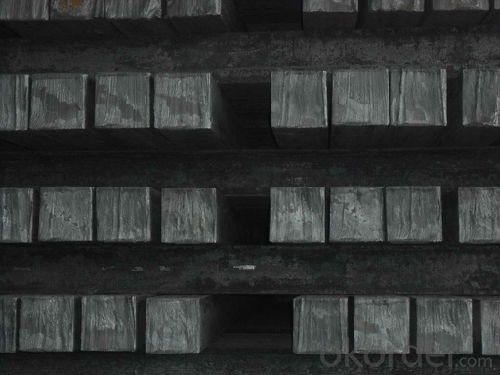
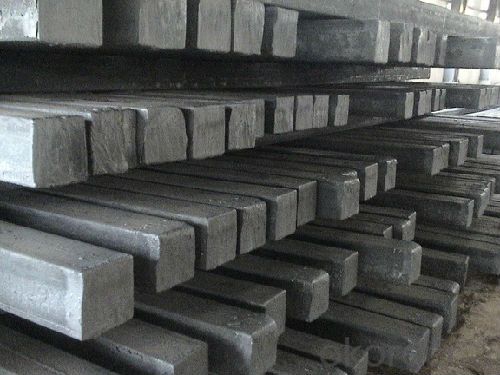
- Q:How do steel billets contribute to the manufacturing of automotive parts?
- Steel billets are the initial form of raw material used in the manufacturing of automotive parts. They are heated and shaped into various components like engine blocks, crankshafts, and suspension parts, providing the necessary strength, durability, and precision required for automotive applications.
- Q:How do steel billets contribute to the overall noise reduction of a structure?
- There are several ways in which steel billets can help reduce the overall noise in a structure. Firstly, they are commonly used in constructing walls, floors, and ceilings, which are important components for sound insulation. Steel's density and rigidity effectively block and absorb sound waves, preventing them from passing through and reducing noise transmission. Moreover, steel billets can be employed to make acoustic panels that are specifically designed to enhance sound absorption and reduce reverberation within a space. These panels can be strategically placed in areas where noise is a concern, such as conference rooms, auditoriums, or music studios. By incorporating steel billets into these panels, their acoustic properties are improved, resulting in better noise reduction. Additionally, steel billets can be utilized in manufacturing doors and windows. These elements often contribute to sound leakage due to their vulnerability to vibrations and poor sealing. By using steel billets in their construction, the doors and windows become stronger and more stable, reducing the amount of sound that can pass through them. Furthermore, employing steel frames and gaskets can create a tighter seal, further minimizing noise infiltration. In conclusion, steel billets contribute to the overall noise reduction of a structure by providing the necessary density, rigidity, and acoustic properties to effectively block, absorb, and reduce sound transmission. Whether used in construction materials, acoustic panels, or doors and windows, steel billets play a vital role in creating a quieter and more comfortable environment.
- Q:How is the quality of steel billets ensured during the manufacturing process?
- The quality of steel billets is ensured during the manufacturing process through various measures such as rigorous inspection and testing procedures. These include visual inspections, dimensional checks, and non-destructive testing techniques like ultrasonic testing or magnetic particle inspection. Additionally, chemical analysis is conducted to verify the composition of the steel billets, ensuring they meet the required specifications. By implementing these quality control measures, any potential defects or inconsistencies can be identified and addressed promptly, ensuring the production of high-quality steel billets.
- Q:What are the different surface defects found in stainless steel billets?
- There are several different surface defects that can be found in stainless steel billets. Some of the common surface defects include: 1. Scale: Scale is a thin layer of oxide that forms on the surface of stainless steel during the heating process. It appears as a dark, rough layer and can be easily removed by pickling or passivation. 2. Pitting: Pitting is localized corrosion that appears as small, shallow pits on the surface of the billet. It is caused by chloride ions or other aggressive chemicals and can lead to reduced corrosion resistance. 3. Scratches: Scratches can occur during handling, transportation, or processing of the billet. They are visible as linear marks on the surface and can affect the appearance and integrity of the material. 4. Lamination: Lamination defects occur as thin layers or flakes parallel to the surface of the billet. They are caused by improper rolling or inadequate bonding during the manufacturing process. 5. Inclusions: Inclusions are non-metallic particles or impurities that are embedded in the stainless steel billet. They can affect the mechanical properties and corrosion resistance of the material. 6. Decarburization: Decarburization is the loss of carbon from the surface of the billet during heating. It appears as a light-colored layer and can negatively impact the material's strength and hardness. 7. Cracks: Cracks can occur due to thermal stresses, improper cooling, or mechanical damage. They can be either surface cracks or internal cracks, and can significantly weaken the billet. It is important to detect and address these surface defects to ensure the quality and performance of stainless steel billets in various applications.
- Q:Can steel billets be painted or coated for decorative purposes?
- Yes, steel billets can be painted or coated for decorative purposes. Painting or coating steel billets not only enhances their appearance but also provides protection against corrosion and other environmental factors. Various types of paints and coatings can be used, such as epoxy, powder coating, or metallic finishes, to achieve the desired decorative effect. These coatings can be applied to steel billets through processes like spray painting, electrostatic coating, or hot-dipping. It is important to properly prepare the surface of the steel billets before applying the paint or coating to ensure good adhesion and longevity of the decorative finish.
- Q:What are the properties of steel billets?
- Steel billets are semi-finished products that are typically rectangular in shape and serve as the starting point for the production of various steel products. They possess several distinct properties, including: 1. High strength: Steel billets have exceptional strength due to the presence of carbon and other alloying elements. This enables them to withstand heavy loads and provide structural integrity in various applications. 2. Ductility: Steel billets can be easily deformed without fracturing, making them highly ductile. This property allows for the shaping and forming of the billets into different products through processes such as rolling, forging, and extrusion. 3. Thermal conductivity: Steel billets have good thermal conductivity, meaning they can efficiently transfer heat. This property is particularly useful in applications that involve heat treatment or require heat dissipation, such as in the manufacturing of automotive parts or machinery. 4. Corrosion resistance: Steel billets can exhibit a certain level of corrosion resistance depending on their composition and surface treatment. However, they are generally prone to rusting if not properly protected, so additional measures like coatings or galvanization may be necessary. 5. Machinability: Steel billets are known for their machinability, which refers to their ability to be easily cut, drilled, or milled into desired shapes and sizes. This property makes them suitable for a wide range of machining operations, facilitating the production of intricate parts and components. 6. Recyclability: Steel billets are highly recyclable due to the inherent recyclability of steel as a material. This property not only reduces waste and environmental impact but also contributes to the sustainability of steel production. Overall, the properties of steel billets make them an essential and versatile material in various industries, including construction, automotive, machinery, and manufacturing.
- Q:Can steel billets be used in the production of construction machinery?
- Construction machinery can indeed be produced using steel billets. Steel billets, which are partially finished steel products, can be further processed into various shapes and sizes, including components for construction machinery. These billets can be hot-rolled or cold-rolled to create different types of steel products commonly used in construction, such as bars, rods, plates, or sheets. Steel's exceptional strength and durability make it an excellent material for construction machinery, as it can withstand heavy loads, resist corrosion, and provide structural integrity. Consequently, steel billets play a vital role as raw materials in the manufacture of construction machinery.
- Q:What is the average price of steel billets?
- The average price of steel billets can vary depending on various factors such as the current market conditions, supply and demand dynamics, and the specific grade and quality of the steel billets. It is important to note that steel billet prices are influenced by global economic factors, including raw material costs, energy prices, and trade policies, which can lead to fluctuations in the average price. To get an accurate understanding of the average price of steel billets, it is recommended to refer to industry reports, trade publications, and market analysis platforms that provide up-to-date information on steel prices. Additionally, consulting with steel suppliers and manufacturers or engaging in negotiations with multiple sources can help determine the prevailing average price in a specific region or market.
- Q:How do steel billets contribute to the manufacturing of construction equipment?
- Steel billets contribute to the manufacturing of construction equipment by serving as the raw material that is shaped and formed into different components such as beams, plates, and pipes. These billets are heated and then passed through various processes like rolling, forging, and machining to create the desired shape and size. The strength, durability, and versatility of steel make it an ideal material for construction equipment, ensuring that the machinery can withstand heavy loads, harsh environments, and demanding construction tasks.
- Q:How do steel billets contribute to the manufacturing of consumer electronics?
- Steel billets are an essential raw material in the manufacturing of consumer electronics as they are used to produce various components and casings. These billets are melted and shaped into specific forms, such as sheets or bars, which are then used to construct frames, chassis, and other structural parts of electronic devices. The strength, durability, and malleability of steel make it an ideal material for ensuring the integrity and longevity of consumer electronics, thereby contributing to their overall quality and performance.
1. Manufacturer Overview |
|
|---|---|
| Location | |
| Year Established | |
| Annual Output Value | |
| Main Markets | |
| Company Certifications | |
2. Manufacturer Certificates |
|
|---|---|
| a) Certification Name | |
| Range | |
| Reference | |
| Validity Period | |
3. Manufacturer Capability |
|
|---|---|
| a)Trade Capacity | |
| Nearest Port | |
| Export Percentage | |
| No.of Employees in Trade Department | |
| Language Spoken: | |
| b)Factory Information | |
| Factory Size: | |
| No. of Production Lines | |
| Contract Manufacturing | |
| Product Price Range | |
Send your message to us
Square Shape Hot Rolled Mild Steel Billet 60mm-150mm
- Loading Port:
- China main port
- Payment Terms:
- TT or LC
- Min Order Qty:
- 1000 m.t.
- Supply Capability:
- 10000 m.t./month
OKorder Service Pledge
OKorder Financial Service
Similar products
New products
Hot products
Hot Searches
Related keywords








